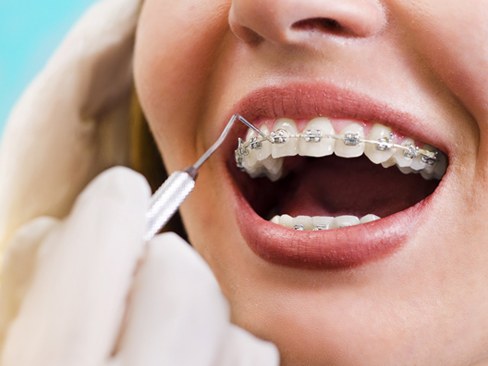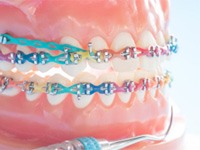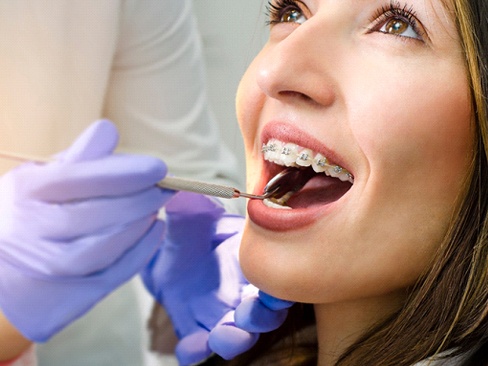
Traditional Braces - Dallas, TX
Giving Patients a Straighter, Healthier Smile
If you have a child or teenager who is in need of a straighter smile, they may or may not be excited about the idea of traditional braces in Dallas. However, we find that most of our younger patients get excited once they learn they can make their smile colorful during the treatment process. Yes, there is metal brackets and wires, but if they desire, they can opt for colorful rubber bands to liven up their new hardware. At Midtown Family Dentistry of Dallas, we’ve been delivering this method of orthodontic treatment for years, so if your child is in need of traditional braces in Dallas, TX, don’t hesitate to reach out to schedule a consultation.

How Do Traditional Braces Work?

Traditional braces are one of the most effective methods for straightening teeth. They have been used for decades to give people of all ages more beautiful smiles. While advancements in orthodontics in Dallas have led to the creation of other teeth straightening solutions such as Invisalign or Clear Correct, traditional braces still hold up to their competition.
Consisting of three parts: brackets, wires, and elastic rubber bands, all three work together to shift teeth into the correct position and alignment. When your child arrives for their first appointment, your dentist in Dallas will use a special bonding agent to place each bracket onto the appropriate teeth. Next, they will thread a metal wire through each bracket, snapping it into place. This wire will serve as an important player in moving the teeth throughout treatment. If at any point while wearing braces the dentist believes it to be necessary that your child wear rubber bands, this is where they can get crazy with their appearance.
Your child can choose from a wide variety of colors to jazz up their smile, all while working toward straighter, healthier teeth. These will help to align their upper and lower jaw.
Who is a Good Candidate for Traditional Braces?

To be honest, traditional braces are perfect for anyone of any age. As long as you have good oral health, you are a good candidate for traditional braces. It is best that if you need any pre-orthodontic dental work completed, such as gum disease therapy, fillings, or extractions, they are done prior to receiving your braces. If some teeth are affecting the potential success of orthodontic treatment, our dentists may suggest an extraction.
What Are the Benefits of Straighter Teeth?

A straighter smile has many benefits, including:
- Increased self-esteem – Children can sometimes be mean, especially to those who might have crooked teeth. With straighter teeth, your child can feel free to smile with confidence.
- Greater oral health – Straighter teeth are easier to clean, which means the chances of cavities and gum disease lessen.
- Reduced chance for wear and tear – When your bite is off, this can put added pressure on certain teeth when biting or chewing. By putting your teeth and bite in proper alignment, this reduces wear and tear of your teeth.
Understanding the Cost of Traditional Braces

You want to straighten your teeth, but first you need to know how much traditional braces cost. After all, how can you commit to a treatment without understanding the financial investment? Fortunately, pinpointing the price of your orthodontic treatment is as simple as scheduling an appointment with our team. That way, we can learn more about your specific dental needs, provide you with an estimate, and review the available financial solutions. Of course, if you want to learn more before your consultation, then you can also read on!
Factors That Affect the Cost of Traditional Braces

Many patients assume that there is a flat fee for traditional braces. However, that’s not the case. Since each patient’s smile is unique, there are specific factors that need to be considered before an accurate price can be reached, including the severity of your misalignment, if you are straightening both arches of teeth or one, and if rubber bands, space maintainers, and other accessories are needed. Don’t worry – we will review all of this information with you at your consultation, and we’d be more than happy to answer any questions you have about your treatment or your financial investment.
Professional Braces vs. "DIY" Braces: Which Costs More?

“DIY” orthodontic companies have attempted to establish their credibility with large marketing campaigns that focus largely on the low upfront cost. Don’t be fooled. These brands cut out important steps of the treatment process to reduce the cost, there are lawsuits from previous patients who have experienced worsened misalignment from their treatments, and professional organizations like the American Dental Association have not been quiet about their distaste for DIY alternatives. In short, if you want to straighten your teeth while protecting your smile (and your wallet) from harm, professional braces are the way to go.
Does Dental Insurance Cover Braces?

That depends. While some patients don’t have any orthodontic coverage, others have a once-in-a-lifetime benefit that can be used to cover a portion of the cost of braces. That’s why we encourage our patients to review the fine print on their dental plan or reach out to their provider directly. We also are happy to welcome all PPO’s and have experience working with some of the most popular providers, including MetLife and Cigna. So, we can help as well!
Options for Making Braces Affordable

If you don’t have dental insurance, there’s good news: that isn’t the only way to make your orthodontic treatment more affordable. We’re proud to welcome flexible financing with trusted third-party financiers like CareCredit. This means that you don’t have to pay for your entire treatment upfront – you can space it out into manageable chunks! We also offer periodic specials, like a free orthodontic consultation, which reduces your out-of-pocket expenses significantly. If you’d like to learn more about either of these financial solutions, then give us a call.
Traditional Braces FAQs

After reading the information above, you know a bit more about why traditional braces in Dallas could be the right choice for your smile. However, it’s completely normal to still have some things you are wondering about. At Midtown Family Dentistry of Dallas, we want you to be as informed as possible before you make the big decision to move forward with orthodontic treatment. That’s why we’ve decided to answer some frequently asked questions below. If you’d prefer to speak directly with a member of our team, be sure to give us a call!
Am I Too Old to Get Braces?
When you think of metal wires and brackets, you may associate them with childhood and adolescence. However, there’s no upper age limit for traditional braces in Dallas, meaning almost anyone can get them! Of course, since adult teeth are more firmly rooted into the jawbone, it may take longer to reposition them into proper alignment. Also, your oral health needs to be in good standing before you can begin orthodontic treatment. Depending on your situation, you may need to undergo preliminary procedures like fillings, root canal therapy, or gum disease therapy. It’s also worth noting some dental insurance plans may not cover braces for adults, so check with your provider before committing to anything.
Do Traditional Braces Hurt?
You may feel mild soreness in your teeth and gums for the first few days after getting your braces. The good news is it’s only temporary and should dissipate. You can manage your discomfort in the meantime by taking over-the-counter pain medication and eating softer foods. Throughout your treatment, you may experience some discomfort as your teeth are shifting into new positions. If needed, you can use orthodontic wax to protect your soft oral tissues and avoid irritation.
Can I Chew Gum with Traditional Braces?
Chewing gum is strongly discouraged because it can easily get stuck in your braces, causing your wires to bend or making your teeth shift in unexpected directions. However, some studies show that chewing gum can actually relieve pain from orthodontic treatment and reduce gum inflammation. It’s also been proven to lower the risk of decay if chewed for 20 minutes after eating a meal or snack. But ultimately, these so-called benefits are usually not worth the risk of harming your braces and jeopardizing your treatment time.
What Can You Not Eat with Traditional Braces?
It’s strongly recommended that you stick to a soft-food diet for the first few days after getting braces in Dallas. You’ll need to be mindful of your diet as your teeth are adjusting to metal wires and brackets. Also, certain foods can damage your wires, brackets, or rubber bands.
Here are a few food items you should avoid:
- Popcorn
- Sticky, chewy, or hard candy
- Nuts
- Chips
- Corn on the cob
I Need a Checkup & Cleaning I am Looking for a Dentist for My Child I am Concerned About Bleeding Gums I Have a Cavity or Broken Tooth I am Missing One or More Teeth I am Unhappy with My Smile I Want a Straighter Smile I am Afraid/Nervous of the Dentist I am in Pain & Need Help I Need My Wisdom Teeth Removed View Our Services